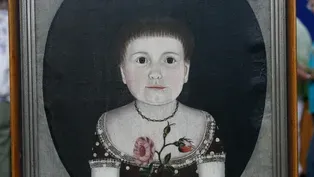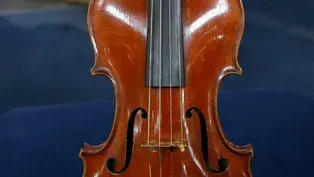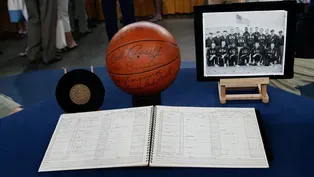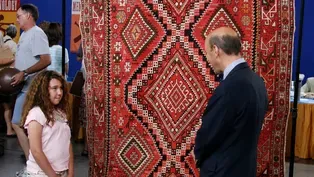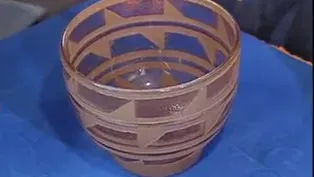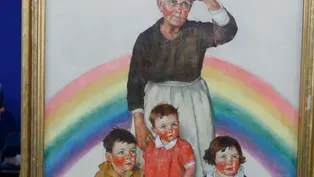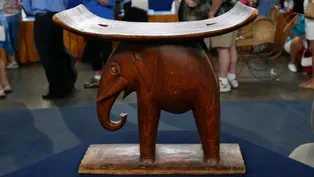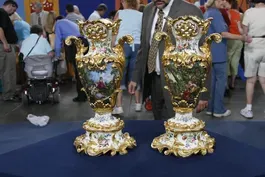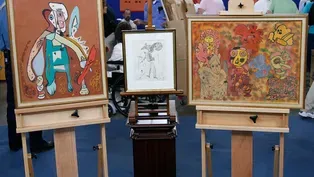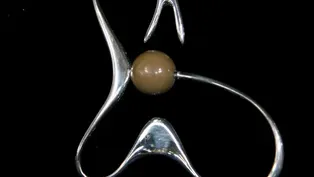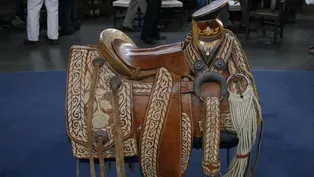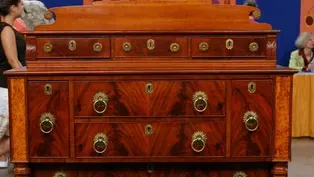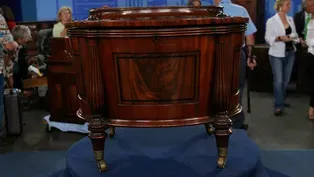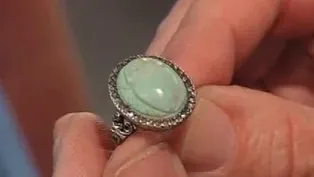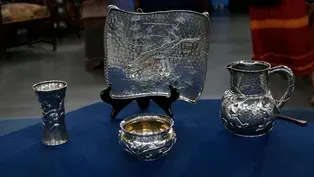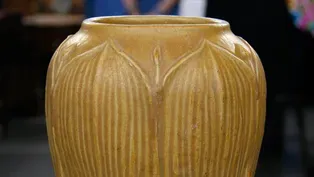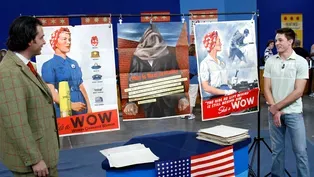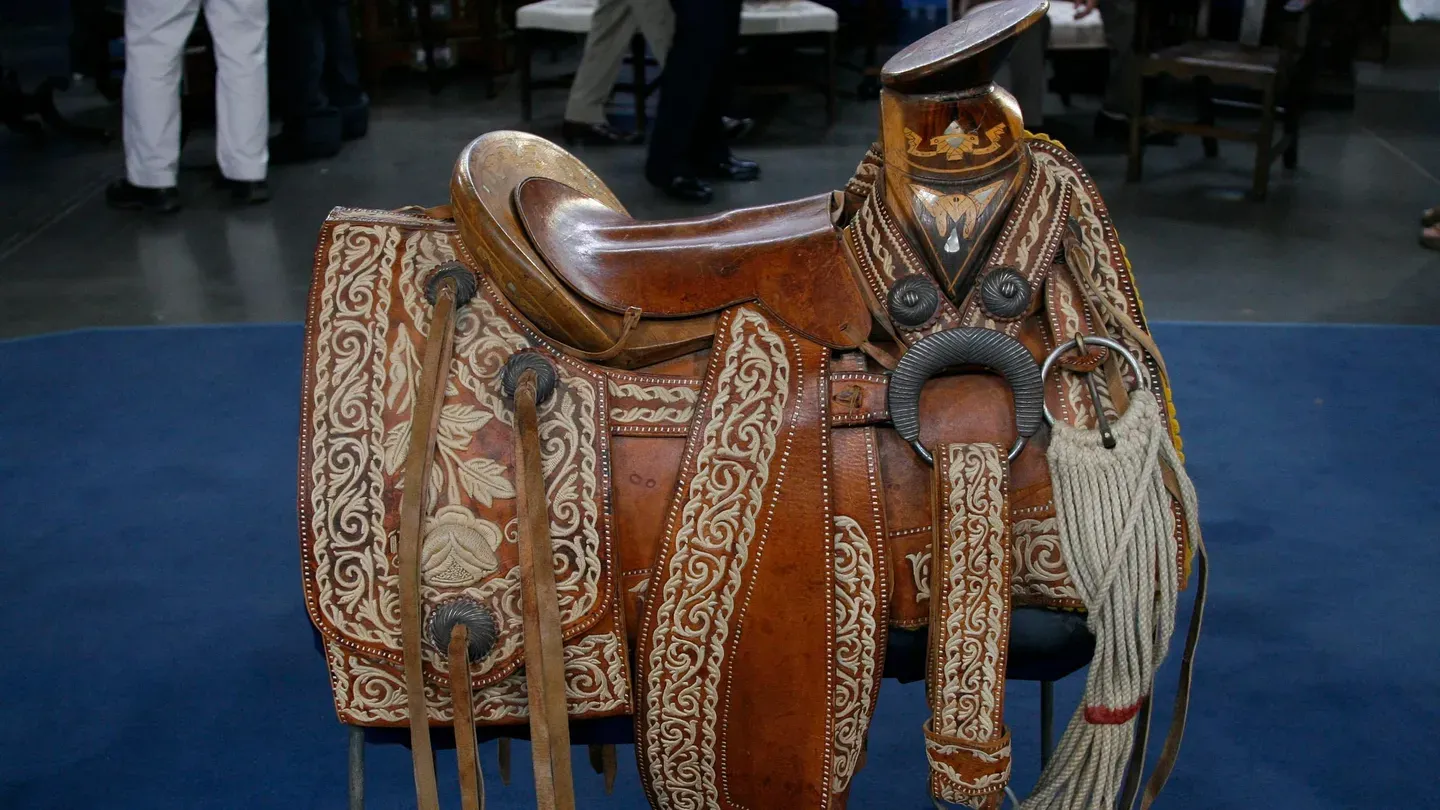

Vintage Tucson 2021, Hour 2
Season 25 Episode 5 | 52m 45sVideo has Closed Captions
Have blazing hot Tucson appraisals cooled down since 2006? Not for one $65K-$110K find!
Blazing hot Tucson treasures include a Mexican charro saddle, Gaston Chaissac artwork, and 1956 Olympics USA Basketball memorabilia. But has the marketplace cooled down since they were appraised in 2006? Not for one $65,000-$110,000 find!
Problems with Closed Captions? Closed Captioning Feedback
Problems with Closed Captions? Closed Captioning Feedback
Funding for ANTIQUES ROADSHOW is provided by Ancestry and American Cruise Lines. Additional funding is provided by public television viewers.

Vintage Tucson 2021, Hour 2
Season 25 Episode 5 | 52m 45sVideo has Closed Captions
Blazing hot Tucson treasures include a Mexican charro saddle, Gaston Chaissac artwork, and 1956 Olympics USA Basketball memorabilia. But has the marketplace cooled down since they were appraised in 2006? Not for one $65,000-$110,000 find!
Problems with Closed Captions? Closed Captioning Feedback
How to Watch Antiques Roadshow
Antiques Roadshow is available to stream on pbs.org and the free PBS App, available on iPhone, Apple TV, Android TV, Android smartphones, Amazon Fire TV, Amazon Fire Tablet, Roku, Samsung Smart TV, and Vizio.
Buy Now

ANTIQUES ROADSHOW 2025 Tour!
Enter now for a chance to win free tickets to ANTIQUES ROADSHOW's 2025 Tour! Plus, see which cities we're headed to!Providing Support for PBS.org
Learn Moreabout PBS online sponsorship♪ I've never, never seen them before.
You're kidding.
My goodness... You are, you are surprising me.
(laughing): Do you know CPR?
APPRAISER (laughing): Do I know CPR... Wow!
(voice breaking): Amazing.
♪ PEÑA: The weather was hot, and so were the values for these treasures when we visited Arizona back in 2006.
Think you can guess which estimates cooled down or rose to new heights in the years since?
Let's find out in this second hour of "Vintage Tucson."
WOMAN: This saddle was given to me when I was four years old by my grandfather, who was good friends with Pedro González, who was the bull master in Nogales.
And Granddad went down and decided to tell this gentleman that he has a beautiful granddaughter and he would like to give her something very special.
And this has been mine ever since.
I only rode it one time, and that's when I ran for Coolidge Cotton Days Rodeo Queen and got to wear that crown proudly on this saddle that my grandfather gave me.
It's a beautiful saddle.
This is incredible work.
A master.
This is cactus fiber.
Oh, my gosh!
This is maguey cactus fiber that's been embroidered onto the saddle.
The silver is from Amozoc, Mexico, that has been chiseled and put on.
The tree is made of mesquite.
That's what this dark color is in this wood.
There's a label on the back.
That is the label of the man who made the tree.
Oh, this part, okay.
Not the saddle, mm-hmm.
The stirrups are silver.
Yes.
The conchos are silver-- they're all iron, but they have silver mounts on them that are hand-chiseled.
This saddle was probably made in the late '30s or the '40s, not when you got it.
Oh.
And, and it was only ridden on special occasions.
Yes.
Has the national symbol of Mexico up on the top.
And this is a burn from a maguey rope that's been dallied.
And the best charros, they can set this horn on fire.
Yes.
And these are burn marks... Let me see.
(hissing) (laughs) These are burn marks around the horn.
Yes, from the dally, yes.
You want to know what it's worth.
Well, you're keeping me in a lot of suspense, and I think that you were tricking me before... No, no.
Okay.
If this came up at a sale in this part of the country, where people know what it is, it would be an easy $6,000 to $8,000.
Wow.
So, you know, pretty good present from somebody.
Yes.
This is a particular style of saddle with the saddle bags that's from the Guadalajara area.
Guada... yes.
If you went to that area and said, "I want a saddle like this, new to use," you would have to pay $10,000 to $12,000, and you would have to wait a year to two years... Wow.
...for this embroidery to be done and finished.
Wow.
So, it's a really special thing.
It's, it's very special to me, and every time I look at it, I remember Granddad.
So, that's, that's the specialness.
That's the best part.
That's the best part, right here.
Thanks for bringing it to me.
MAN: We have a autographed basketball from the 1956 Olympics.
My father was the trainer, and these are some of the stuff he brought back with him.
APPRAISER: A great team.
Yeah.
A gold medal-winning team.
Oh, yes.
Led by Bill Russell and K.C.
Jones.
Here we have an original photograph of the team.
Uh-huh.
Here's Bill Russell... Mm-hmm.
And here's K.C.
Jones.
Oh, that's K.C.?
Okay.
Yep.
And, and here's your dad right here, the trainer.
Yeah.
And this is pre-Celtic dynasty, before Russell joined the Celtics and created perhaps the greatest dynasty in all of sports.
Here we have the original scorebook... Mm-hmm.
...from Melbourne, Australia, 1956.
Here we have it turned to the gold medal winning game... Yeah, the final game.
...of the U.S. vs. the USSR.
Now, this team outscored their opponents by at least 30 points in every single game they played.
Yep.
So, I mean, this is unheard-of.
Yeah.
They cruised to the gold medal, and we very, very rarely ever see scorebooks from the Olympics.
How did this come into your dad's possession?
One of the gentlemen that was involved in the team-- I think he was the assistant coach-- mailed it to him, and sent him a letter, and said, "Add this to your collection.
"And thanks for all your help in making it a successful Olympics."
Sort of a souvenir.
Yeah, yeah, yeah.
And I know we also have your dad's participation medal from the Olympics.
Uh, yes, that's, I think that's what this is.
And, and that's also a great piece, but the gem of the whole thing is this basketball.
It looks brand-new.
Yeah, well, it's been sitting in a closet in a plastic bag for 50 years.
It's amazing because, generally, when you see a basketball this age, it's crackling, and, certainly, if it's been autographed, the signatures are kind of worn off.
Right.
But this looks like it was signed yesterday.
Yeah.
And, of course, we have Bill Russell's signature here.
Right there at the top.
A very rare signature.
He didn't like to sign, but, obviously, he, he liked your dad.
I guess.
And he signed a big, bold signature there.
And then we have K.C.
's signature here and your dad's signature right there.
Yeah, the whole team.
What an amazing ensemble.
Very, very rare to find basketball memorabilia of this era.
You got Olympic collectors who'd just go crazy for it.
And, of course, basketball collectors.
And then you got the Celtic guys.
As far as a collection, I would sell it as such.
In an auction... Yeah.
I would estimate it at least $8,000 to $10,000.
Wow, that's a pretty good price.
But it's never going there.
And you're talking about condition here with the ball, you're talking about rarity with the scorebook.
If you were to insure it, I wouldn't insure it for anything less than $15,000.
Yeah.
It's impossible to replace this.
Well, it's quite a rare Patek Philippe watch.
It's called an Amagnetic.
It looks very humble.
It has a special cap on the back, which is designed to resist magnetism, and the entire escapement is specially designed.
It's a kind of a scientist's watch.
This example has a beautiful original dial.
Has a screwback case on it.
They made the anti-magnetic from the mid-'50s to the early '60s.
It is a, what we call a salesman sample.
My colleagues and I have looked at it here and think that it's probably somewhere in the first half of the 20th century, 1920s, 1930s.
As you can see, originally, you know, a coffin would be lined.
WOMAN: They belonged to my father's grandfather, and he was born in Lexington, Kentucky, and then grew up in Atlanta before he came west in the early 1900s.
Each piece is so remarkable.
The canes are really intricate, interesting, dated, signed.
This, this cane on the end has so much intricate work and... We call it a puzzle cane.
The other canes are equally detailed, and I love that it tells the journey of his trail out west.
This carving is especially interesting, given where we are, because he's in Tucson, Arizona, in 1938.
As a group, we would estimate them at auction for $12,000 to $14,000.
You're kidding.
My goodness.
Oh, my gosh!
You're kidding!
They're great.
They just stand in the corner, and we pull them out at holidays and look at them.
We never... We never think of them as anything other than that.
They're excellent, they're great.
Oh, my...
They're great carvings.
Thank you so much.
You're welcome, thanks for coming.
Thank you.
Oh, thank you.
(laughing) Oh, don't cry.
(crying): Oh, you've got to be kidding.
I'm not kidding.
We were dropping them outside!
Well, Nadine, this piece of jewelry was made by your friend?
Yes.
Tell us who your friend was.
José Ruiz de Rivera.
Uh-huh, and he became quite a famous sculptor after you first met him, right?
Yes, yes he did.
Uh-huh.
And he made several pins like this and gave them to friends as gifts.
Uh-huh.
And we have this wonderful picture of you with Rivera here on the beach at Fire Island, was it?
At Fire Island.
Uh-huh.
And that's you?
Yeah.
Yeah.
And then he was drafted, or he went into the Army, anyway.
Uh-huh, uh-huh.
He wrote me that letter, which is a wonderful letter.
Uh-huh.
So I've always kept it.
And when you met him, was he a struggling artist or, yeah?
Yes, you'd say that, yeah.
And he...
Lived in a little dingy garret.
When he started out, he worked for the Works Progress Administration, which got him through the Depression.
And he became quite successful in the mid-'50s and the 1960s...
Yes.
...making these abstract sculptures...
Yes.
...that look a little bit like the pin that he made for you.
Yeah, uh-huh.
His work is in major museums, the Metropolitan Museum of Art, the Smithsonian.
He did these wonderful large, monumental pieces.
And he was friends with another sculptor who made jewelry.
He was a friend of Alexander Calder.
That's right.
He called him Sandy.
His work is very highly sought-after now.
It is.
Yeah, it's very, very popular.
It sort of epitomizes the modern movement of the 1950s, with these wonderful, sleek, elegant forms.
Some of his pieces rotated and moved, didn't they?
Yes.
And did you stay friendly with him?
Yes, yes.
Through his career?
Then I left New York, about 1948.
But we corresponded.
And when did he give you the pin?
About '44.
He was especially noted for the beautiful finish.
It is nice.
I mean, it's made out of sterling silver.
It has this wonderful bead here on it.
It's signed on the back.
Yes.
And he fabricated the whole thing himself.
It's really quite beautiful.
Yes.
I would think at auction, it would probably bring between $5,000 and $7,000.
(chuckling): Oh, okay.
That's good to know.
These belonged to my great-aunt and -uncle, who were pioneer family founders in Northern Arizona, in Flagstaff.
My great-aunt came from Omaha, Nebraska, as did the artist.
I don't know if there's any other connection than that, but my family had a sheep ranch in Flagstaff, and he could very well have gone out with the sheep ranch and gone up on the reservation and painted the pictures.
But other than that, I really don't know much more about him.
Well, the artist, Augustus Dunbier, who signed each of these paintings in the lower left, does have connections, as you said, both to Omaha and the West.
When he studied at the Chicago Art Institute, he met a fellow artist and teacher, Walter Ufer, who was one of the Taos School artists.
Oh.
And Ufer invited Dunbier to come out to New Mexico in 1920.
So he starts spending time every year in the West.
Even though he traveled a great deal, he would always go back to his studio in Omaha, where he painted for 62 years.
Wow!
Taught many classes, and he had much good advice for his students.
One piece of advice that I particularly liked was, "Don't paint what you see."
He felt that the artist should manipulate the color to create a certain mood.
He often would make his own frames.
He would carve the wood himself, and these are each in a lovely hand-carved frame.
Right.
Whether Dunbier actually made these, I'm not sure.
Mm-hmm.
But it's something that could maybe be ascertained with more research.
Mm-hmm.
So here we have a scene of a horse in what looks to be a very hot day in the landscape.
And here are some Indians also taking some respite from the sun...
Right.
...in a landscape.
And I think if these were to sell in a retail situation... Mm-hmm.
This one might be around $5,000 to $7,000, and this might be around $4,000 to $6,000.
Wow!
(voice breaking): Amazing.
So I'm really glad to see some paintings today with some Arizona connection.
Yeah.
Thanks so much for bringing them in.
You're welcome.
Thank you.
I told you I was gonna cry.
(laughs) MAN: I got it from a friend about 1982 or so.
We used to go to the swap meets every weekend, and I saw him leaving the swap meet in Tucson with this under his arm, and I said, "Wow, is that ever cool?
Just out of curiosity, what did you pay for it?"
And he said he paid ten bucks for it.
And I said, "Oh, my gosh, did I ever miss that?
If I had been here half an hour earlier."
And I told him, "If you ever decide to sell it, I want it."
And about three or four years later, he called me and said, "I'm leaving town.
"I'm selling all my stuff.
If you want that pot, I'll sell it to you."
He paid ten...
I paid $20, so he had 100%.
He doubled his money.
He doubled his money.
And you are hoping that it is what?
It looks like a Grueby vase, more or less.
It definitely looks like a Grueby pot.
Very organic, with the, with the carved leaves and the buds and the three buttressed feet.
There are some very faint marks, nothing legible.
One of the things that Grueby did, and some of their competitors did, was copy shapes and glazes from European art pottery about the same period.
And this piece probably dates from, say, 1900 to 1910, but they weren't the only ones to borrow shapes from other companies.
The fact of the matter is, this is not Grueby.
Oh, okay.
But we're going to solve the mystery.
Great.
This is a Cincinnati piece of art pottery.
Oh, really?
This is actually a piece of Wheatley, Thomas Wheatley, who worked in Cincinnati for a number of years-- actually worked for Weller in the late 1890s and then came back to Cincinnati and started doing these wonderful Arts and Crafts pieces very much in the same style as Grueby.
It is hand-thrown and carved?
No.
Or is it actually molded...
This is a molded piece, where Grueby would have been hand... Ohh.
Okay.
...hand-thrown and all the stuff carved, but very nice.
Okay.
And the glazes are usually pretty good, too.
Yes.
It's definitely Wheatley.
I've had this form before.
Okay.
I can assure you you're gonna be happy with, with the value, even though it's not Grueby price.
At auction, this would sell for somewhere in the $1,500 to $2,000 range.
Oh, wow.
Even with the small chip on the foot.
Okay.
Because it's a, it's a nice form, it's a nice color.
Uh-huh.
The glaze and the texture is what draws me to it.
It just, it's the kind of thing you just want to touch it and feel it.
Had it been Grueby, we'd be talking about 20-plus thousand dollars.
WOMAN: Well, it belonged to my late husband.
It was given to him on his 16th birthday.
He played small violins till then.
This was his going up to the big one.
He was a beautiful musician.
He died about 25 years ago, and it was left to me.
I knew it was old.
He thought it was quite old.
He insured it for quite a bit.
After my husband died, I took it to a violin teacher.
And he kind of appraised it a little bit.
But he told me that it was a Paul Bailey.
He found a date inside that said 1883.
APPRAISER: Well, you're absolutely spot on, and the maker is Paul Bailly.
Bailly.
And of the 19th-century school of French, and specifically Parisian, makers, he's one of the better.
Paul Bailly trained in Mirecourt.
Leaves Mirecourt, goes to Paris and works with Jean-Baptiste Vuillaume-- without a doubt the most respected maker of, and shop of, the mid-19th century.
And here he learns how to make violins in the true Parisian style.
Classic workmanship, beautiful varnish on it.
And how these Parisian makers shine is, the work is very crisp, very clean, and wonderfully proportioned.
I think Paul Bailly had a bit of the wanderlust in him.
He worked in Brussels, he worked in London, and even rumored to have come to New York, although I've never seen examples of his work coming from the United States.
The label shows how he marketed his instruments.
It refers to three medals that he won in different exhibitions-- one in Brussels, one in Sydney, and another one in London.
You had it appraised at some point?
Well, he told me that if a person was looking for a certain violin and knew what this violin was, it was worth probably between $8,000 and $9,000.
And this was about 20... 1982, '83, somewhere in there.
Okay, okay.
You know, I think he was probably close then, though we've seen a pretty healthy increase in the market.
The auction record for a Paul Bailly of this quality is $20,000.
Oh, really?
Oh!
So we've seen a good increase.
Oh, my goodness.
Um, I would say... You know, you had asked about insurance valuations.
I have heard of fabulous examples like this selling in the retail market for upwards of $35,000.
Oh, my gosh.
Wow, I-- I, I knew...
I was thinking maybe $10,000, maybe somewhere in there, but I had no idea.
It's a salesman's sample of fruit trees.
What I particularly like about them is the printing.
APPRAISER: The colors are vivid.
The printing process here just brings these to life.
I wanna bite into that apple.
This is classic Schoharie County, New York, near Albany.
Okay.
Schoharie in Albany County, vase, decoration.
Right.
This is a... signature decoration.
Untouched, dramatic-- I love it, I love it.
Got the original feet.
A lot of drama.
That book belonged to my mother, and it was presented to her by Helen Keller.
Directly from Helen Keller.
Yes.
And she knew your mother how?
My grandmother was president of the Rhode Island Association of the Blind in 1938.
And when Helen Keller and her companion Anne Sullivan came to Providence, they stayed with my grandmother.
And that was how my mother met Helen Keller.
Wow.
What a great story.
What's especially nice about this copy, it's a first edition of Helen Keller's journal, and that was published in 1938.
And what's really most striking about it is this inscription inside, which is to your mother, which says, "I send this journal "because of her beautiful compliment "that I am not blind or deaf to her.
Gratefully, Helen Keller, March 11, 1938."
She had to write with the help of a guide.
That's why it looks very angular and straight.
Yes.
The handwriting, the sentiment of that, is just so, so significant and touching, especially the relevance with your, with your mother.
It's very important.
Yes.
And because of that, I mean, it's a book that ordinarily might be a few hundred dollars.
Mm-hmm.
But because of that inscription and the warmth of it, we would put the value at $1,500 to $2,000.
How nice!
But I'm sure it's, it's priceless to you because of, because of, it's to your mom.
It is, yes.
MAN: They belonged to my great-grandmother.
She worked for the Department of War and, uh, Department of Labor.
And then, she was a pack rat, and I mean, she just... She loved to collect things.
How many of them are there?
I'm guessing about 50.
I pulled out a couple of very specific and interesting pieces to talk to you about.
The ones on either end are a very famous figure in American World War II history.
It's Rosie the Riveter.
And one of the reasons why I love these posters so much... Uh-huh.
...is that she is such a popular character.
Mm-hmm.
And her image is so well-known, but you actually very seldomly see the posters.
Uh-huh.
Now, these are advertising the Woman Ordnance Worker program...
Okay.
...where women were making shells in factories while the men were away, and, in fact, the one that's closest to you actually says, "The girl he left behind is still behind him."
Very, very popular, and surprisingly, really rare in the world of World War II posters.
Okay.
Now, very differently is the poster that's in the middle here.
Now, this poster is by a very famous artist whose name is Ben Shahn, and his name appears on the poster, and the story behind this poster is a page right out of your history class.
Okay.
In 1942, the Czechoslovakian Resistance assassinated Heydrich, who was one of the high commandants in the Nazi army in Czechoslovakia.
Okay.
And in retaliation, the Germans liquidated an entire village in Czechoslovakia.
They killed all of the men and deported all of the women and children to concentration camps.
Okay.
The town was called Lidice, and this poster is so somber and so grim, of a, of a shackled man with his head in a bag up against a brick wall, and it's meant to look sort of like a radio dispatch saying what happened.
Now, another image is this image up front, and it seems like a very simple poster.
It says, "Give it your best!"
It was meant to increase production in factories.
Okay.
The poster is not signed, but we know that it's by a very famous artist named Charles Coiner.
And this poster, because of its clear and obvious patriotism, is actually also very desirable on the market.
Finally, I want to show you something that I've never seen before, and this is a group of posters for something called the O.P.A.
And the O.P.A.
is the Office of Price Administration.
Okay.
Which existed during the war specifically to keep people from profiting on gasoline, on rent.
And these are a very creative, very modern series.
They really, they don't seem like they're from 1945.
They seem much more recent.
I've never, never seen them before, and in fact, only just today, when I went online to do some research, learned what the O.P.A.
was.
I'd never heard of the Office of Price Administration.
So I think these are very exceptional.
You see that all the posters are folded up.
This isn't a condition issue.
These posters are folded as issued.
They were mailed out around the country, and they're always folded like this so they could fit into envelopes.
If I had these posters at auction, I would appraise them in the following way.
The two posters of Rosie the Riveter, each by Adolph Treidler, by the way, a very famous artist...
Right.
I would estimate each one separately at $1,500 to $2,000.
Okay.
The Ben Shahn poster I would estimate at $800 to $1,200.
Okay.
The Charles Coiner, "Give It Your Best," the American flag, I would estimate at $700 to $1,000.
Okay.
And all of these posters for the Office of Price Administration, as a group, I would estimate this group alone at $1,500 to $2,000.
Oh, cool, okay.
So together now, we're looking at between $6,000 and $8,200, and that's just for the ones we're looking at, not for the other ones that are in the pile.
Okay.
Really... How does that sound for a piece of history?
That sounds great-- I had no idea.
WOMAN: Someone had passed away, and I was invited into the home.
And the maid was sitting in the kitchen, and I talked to her a bit about the people that had lived there, although I didn't know them.
And she mentioned that there was some lovely china up in the kitchen cabinet.
So I asked if I could look at it, and they opened up the cabinet.
And lo and behold, this is what I found, and I said, "I'll buy it."
What we're looking at is a collection of painted English teawares.
This is oftentimes called a trio, because you've got a teapot, creamer, sugar.
But in this case, you have cups and saucers.
What is important about this particular service is that each piece has a hand-painted scene right in the center here, okay?
Beautifully done.
Absolutely gorgeous.
This is really the best of what England had to produce in this time period, which is the Regency time period, around about 1815, 1820.
Now, can't you just imagine wandering around these sort of bucolic landscapes?
They're absolutely gorgeous, and a lot of these painters now are identified, but they didn't sign their works then.
They were employed by the factories.
So you had a great deal of research that goes on later to tell people how great these English porcelain artists were.
What is good about this, on the front, on each piece, is that you have the scene here.
Yes.
But what is also really important in a condition perspective is that it's got the beautiful cobalt blue background here...
Yes.
And the gilding, which is in absolutely wonderful condition.
It might have been that these only got used on the very most important special occasions, so they didn't see a lot of wear, and oftentimes, when you stack the dishes together, you'll get what's called stacking wear on the gilding.
You don't see that here.
Now, on the back, you have the English titles.
This is "In Cumberland" and it has the Crown Derby mark.
Yes.
And the fact that they're titled and they're not anonymous is really important.
Anything that is titled like this is topographical and an actual scene.
So that's also very much a plus to what it is.
Now, we, we talked about the condition issues.
And I wanted to point out one more thing here, and that is on the creamer.
It has what are called staple repairs.
Yes.
And staple repairs are, to our eye today, very, very harsh repairs, but that was considered a very acceptable repair in the late 19th century.
So we look at it now and say, "Hey, we can undo that and redo it."
You only brought a representational set of what you have here, but I would say that what is on the table is probably worth around $3,000.
My goodness.
Well, I have seven teacups and eight coffee cups and eight deep saucers and a creamer and a tray and a teapot.
So you've got a lot of extra stuff.
Oh, I have quite a bit.
Okay.
But I didn't want to bring it all down.
Well, assuming that's all in good condition...
It's all, this is... ...and I'm just saying, I'm not seeing that, I would say that the set together at auction would bring around $6,000.
Hm!
Not a bad investment for $250.
No, but it wouldn't be for sale, either.
(both laugh) APPRAISER: This is a classic Korean form.
So you find this shape in Korean ceramics.
This happens to be gilded bronze.
So the other clue that we have is, when we turn this over, there's this mark on the bottom.
Mm-hmm.
And that says this is number 11.
So this is actually part of a Buddhist altar set.
It was for a very wealthy Buddhist temple, most likely made in the 18th century.
APPRAISER: This is a wonderful sewing kit, and sewing collectibles have become so popular recently, and this goes back to the days when women would go after dinner and they would sew together, and they always wanted to have very nice-looking tools to carry with them.
So this was probably a presentation piece, and when I initially looked at it, I thought it was gold with wonderful turquoise inlay on it.
But I found a hallmark, and it is actually vermeil, which is silver with the gold on top of it.
And this piece is particularly interesting.
If you push it one way, you have a writing nib, and when you go the other direction, you have a little pencil.
It all matches, it's made to fit in this ebony case.
This is a very interesting ring.
It's a scarab ring, and it's surrounded by diamonds.
But what I found most interesting about the piece was that it opens up, as I think you knew.
Yes.
And when you open it up, there's this interior screen here.
Do you have any idea what this is?
All I know is, my mother told me it was a poison ring.
(laughs) Ah, it's...
It was very dramatic.
History of Lucrezia Borgia.
(laughing): Yes.
Unfortunately, there's not, no Lucrezia Borgia here.
What's interesting is that this is actually called a vinaigrette or a scent ring, and what ladies would do in the late 19th century, they would have a piece of material in here soaked in, say, a perfume.
And if they were walking down the street and they walked by some garbage or something that smelled ill to them... Oh... ...they would hold this up to their nose, and it would be a fresh aroma by which to help revive them from the noxious odors of walking in the streets... (laughs) ...in the 19th century.
So it doubled as a piece of jewelry and as a scent flask, so to speak, to hold it.
Oh, my heavens.
It's a great little piece here.
The Egyptian motif is kind of interesting, because when they started unearthing a lot of the Egyptian tombs in the late 19th century, it became all the rage.
Hence the beetle.
So a piece like this, value on this would be somewhere between $800 to $1,200 at auction.
It was in the costume jewelry box in my mother's drawer.
(laughs) Well, it's not costume.
Wow, well, that's very interesting.
And I'm glad to hear it really wasn't a poison ring.
Unless you do want to use it for that, that's your business.
WOMAN: Around 1938 or '39, my uncle came to my parents' home, and he saw that there was a very large stone fireplace with nothing hanging on it.
He looked at it, he said, "I have just the painting for that fireplace."
So, a few months later, this arrived in the mail.
Uh-huh.
And this was a "Post" magazine cover from about 1937, I believe, by Ellen Pyler.
Uh-huh.
And the editor of "Post" magazine was a good friend of my Uncle Lou's, and my Uncle Lou had mentioned how much he liked the magazine cover.
Yeah.
So he said, "I think I can get the original for you if you would like to have it."
But, evidently, this didn't fit in with Aunt Pauline's decor.
Okay.
So he was looking for a place to put it, and when he saw the mantel over the fireplace, he said, "This is it."
So that's how they came by it.
Right.
It looks like it's "Pyler," but it's actually Ellen Pyle.
Pyle, oh, all right.
Yeah.
And that's an important name in the history of illustration.
A man by the name of Howard Pyle ran an art studio in Chadds Ford, Pennsylvania.
And he ran a school for illustration art.
And he taught many of the great illustrators-- N.C. Wyeth and others-- and he was teaching a woman by the name of Ellen Thompson, from Philadelphia.
Well, Ellen Thompson was in this class in the late 1800s, and she met up with Walter Pyle, Howard Pyle's brother.
Well, they got involved.
The problem was, Walter was married and had a child, so she got banished to Philadelphia.
Ah-hah.
And her parents took her out of the school.
But they eventually got married in 1904, and then he worked near Wilmington and had a leather business.
But suddenly, he died in 1918, leaving her with four young children.
And so she went back to her old art school training and became an illustrator.
Well, she did that for the next 20 years almost.
She lived until 1936.
This is-- at the same time, you had people like Norman Rockwell doing "Post" covers, as well.
Now, these are the materials a commercial artist would use.
That's oil on a commercial artist's board, a board that would be used for production.
And she has a very colorful palette.
You see this rainbow here, and also these very bright cheeks of the, the children.
I think they're enhanced because it makes it read better on a magazine cover.
Yes.
The thing about illustration art right now, it's very, very hot, the market is.
It's very strong right now.
And what also helps is the fact that this is a "Saturday Evening Post" cover.
It's one of the most sought-after magazines.
Other magazines are nice to have, but the "Post" is what people collect.
Ellen Pyle, she did, she did about 40 "Post" covers, but only one or two have come on the market.
I would put a value on it probably about $25,000 to $35,000 at auction.
Really?
Oh, gosh.
Yeah.
I had no idea.
Yeah.
That's wonderful.
I got it at the Tucson local swap meet.
A swap meet?
What did you have to swap to get it?
Um, $200.
What else did you buy that day?
Anything else?
No, just the rug?
Uh-huh.
What made you want a rug?
It looks expensive.
(chuckling): That's a good reason.
It hangs up on the wall in our living room.
Oh.
You must have big walls.
Do you know where this rug comes from?
It comes from an area called the Caucasus Mountain Range, and this was woven in a village, so it would have been done by children, probably, you know, not much older than you.
If you look right here, there's birds in this rug.
and there's other birds up and down the rug.
Another one here, and this animal here with the four legs... Mm-hmm.
And the big tail, and the antlers, what do you think that is?
A deer?
A deer.
Probably a reindeer.
Do you know how old it is?
I think it came from the 1920s or '30s.
Probably a little bit earlier, probably about 1900.
So it's a little over 100 years old.
And there's two reasons why a rug like this are valuable.
One reason is because it's collectible.
People who collect unusual rugs would want a rug like this, but also, it's so large.
It's probably almost 12 feet long.
So you paid $200.
Now, would you be surprised if I told you this rug is worth maybe as much as $5,000 at auction?
It's pretty good, huh?
Mm-hmm.
It's a good investment.
WOMAN: They came from my great-aunt, um, probably about 20 years ago.
I was in my early 20s, and she had received them in her early 20s from her husband's grandmother.
And she didn't have children with him, so they came to me.
APPRAISER: All four of these wonderful pieces are by Tiffany and Company of New York, which we know based on the markings on the underside of each.
And the dating is signified by the letter within the mark.
So in this case, that letter stands for 1873 to 1891.
So all of those pieces bear that same date letter.
They represent why the Tiffany name is, is so renowned.
You can take away the decoration, just the handling of the metal-- this hammering just makes beautiful facets.
It's all sparkling like a diamond.
All of these pieces are what we would call Aesthetic Movement.
And the Aesthetic Movement was a style of decoration that looked a lot toward Asia and the East.
So all four of these pieces show a lot of Japanese influence.
The naturalistic decoration, the use of florals.
And in two of these cases, the use of monkeys.
So I'm wondering if there was any family connection with monkeys.
Uh, you know what?
I don't know.
In the back of my mind, I remember hearing something about a pet monkey.
Oh, really?
But, you know, I don't know for sure.
Yeah.
And it was so long ago that... At the time, I wish I'd asked more questions, but I just loved it because it felt to me contemporary.
The idea of a pet monkey is not outrageous.
This would have been a custom-made piece.
Okay.
And the reason I know that is, it has an acid-etched monogram.
But over the top of the monogram, they placed these monkey figures.
This was expensive when it was purchased.
This piece with the frogs is fantastic quality.
This is all top-notch American silversmithing.
Beautiful, beautiful quality.
This piece has mixed metal, which you can see on the back of this diving frog-- copper inlay.
And the back of the frog is gold wash. Mm-hmm.
So there are three colors on, on one piece.
This is fabulous stuff.
You're looking at, for auction, and I think that this is a little conservative-- but I would say the spill vase with the, with the tangle of monkeys, I could see that doing $3,000.
The bowl with the frogs, probably $6,000.
Mm-hmm.
The mixed-metal tray, $10,000.
And this amazing pitcher with the monkeys, $15,000.
Wow.
So, which brings you to a total of $34,000 worth of amazing American silver.
(laughing): Wow.
So it's, it's...
It's beautiful what I would call lust-worthy silver.
So I would certainly...
Thank you for bringing it.
I've loved seeing it.
Thank you.
APPRAISER: Tell us how your family got it.
WOMAN: I think it was an estate sale or an auction.
Long Island, New York.
It was your dad?
My dad.
And so, about what time would that have been?
I know it's been around over 50 years.
50 years.
So, yeah.
Okay, so did your dad tell you anything about the piece?
No.
All right, this stool is from Ghana.
Mm-hmm.
There's two tribes that do these stools.
Mm-hmm.
The Ashanti and the Fanti.
This particular stool is from the Fanti.
This piece was not made for tribal use.
This piece was commissioned, 1910 to 1930, by a colonial for a Fanti carver to carve this for him.
There's a couple of ways that we know that.
Hmm.
The colonials were a little bit taller, so the stools are bigger.
Now, these stools, in a traditional context, are for prestige and status.
Only the wealthy people could have these in their homes.
So, ironically, you have a colonial commissioning a piece for exactly the same reason-- as a prestige piece for his home.
Now, in African art, we have decorative pieces, we have reproductions, we have fakes, we have folk art.
Since this is a piece that is commissioned for sale, it's not a fake.
I really look at these now more as folk art.
And this is really a terrific example of a Fanti stool.
The elephant is a symbol of power.
We have inlaid eyes.
We have one little problem on the back here.
We do have one broken tusk.
Now, that's going to detract a little bit from the value.
Mm-hmm.
Now, one other thing that I want to show.
If we look down here, we can see that we definitely have wear on the seat.
In African art, once we know what something is-- whether it's a mask, a stool, a figure-- we want to see a wear pattern that is appropriate for that kind of object.
This has been used in your family.
Yes.
And that's great.
So we have a terrific piece here, beautifully carved.
In my gallery, this would be $600 to $900.
Okay.
In the decorative market-- that is, if somebody had this in a decorative center or a designer came in, and then the designer put it into a home-- it could be $1,000 to $1,500.
Really?
Well, my father and I were yard sale-ing, and he bought a nuts and bolts bin for a dollar at a yard sale, and found this.
Wow.
And found the watch tucked in the back of one of the drawers.
And he gave it to me before he passed away in February.
APPRAISER: Not only is it a great example of an Art Deco lady's wristwatch... Uh-huh.
It happens to be a Tiffany and Company wristwatch, which makes it even more special.
Oh, wow.
And Tiffany and Company outsourced a lot of their manufacturing to Swiss watch companies.
This particular watch was manufactured by Patek Philippe.
Oh.
Which is the premier Swiss watch manufacturer.
WOMAN: This piece has been in the family for quite a number of years.
And a couple of years ago, my parents needed to downsize from the big house, and, you know, there was just too much... Sure.
...to go into the smaller house.
Exactly.
And I've always had a passion for Art Deco, so this bowl just had my name all over it.
What attracted me to this bowl was that this has a very Southwest design to it, even though it is high-style Deco.
And it is a Daum Nancy piece, made in France, and it has the stippling effect here from the acid and this raised cameo relief.
It is signed around the base.
It's sort of a coupe shape-- like C-O-U-P-E, coupe shape.
And Daum had three major periods of time.
They had Art Nouveau, Art Deco, and Postwar.
And this is high-style Art Deco, and we feel that the bowl is in the... About the $2,000 range in a retail establishment.
So it's a very nice bowl.
Oh, my goodness.
Very nice bowl.
I guess I won't be serving potato chips in it anymore.
No potato chips.
MAN: We inherited this from my mother-in-law.
She called it a wine cooler.
I tell people that I keep a six-pack of beer in here at all times.
APPRAISER: Six-pack of beer.
We think that it came from England.
She paid around $1,500 about 1952.
I don't know its history, but it looks like somebody had this in a special place where they were dipping wine...
It was a special place.
...or whatever they're, so... You're right there.
Do you have any idea of, of the age?
I'll guess 1800s, but I don't know.
What you brought, and it's really, it's got-- I'm pretty excited about it-- is a wonderful Regency cellarette, which is also a wine cooler.
So when you said you like to keep, you keep a six-pack in it once in a while, that's, that would be a good thing to put in here, because it was made to hold libations, right?
It typifies, as a cellarette, the Regency period.
The term "Regency" comes from the Prince of Wales who ruled as the prince regent during the illness of his father.
And he ruled between 1811 and 1820.
This is made probably right around somewhere in the 1820s.
And it was made in London.
And when you open up this top, right on top here, and it actually says, "T. Wilson, Queen Street, London."
And we found out that he was a retailer of furniture in London and he lived from right around 1799 to the 1850s, so we know... We know who retailed this-- it wasn't who made it.
This could have been made by one of the great London cabinetmakers-- the quality's amazing.
You have these ebonized caps on top.
Wonderful reeding on this freestanding, almost, column.
You see how you can put your finger around the back here?
And then these tapered feet with wonderful brass casters.
And so the panels here, which, they really feature, are these mahogany panels with ebony banding.
The ebony was often imported into London.
And it's that contrast that makes the piece great-- the contrast between the solid mahogany, the veneers, these wonderful crotch-figured mahogany, and then the, the inlay.
So all together, it's a beautiful thing.
This has a lot of pizzazz.
In a shop in, let's say, in New York, you'd price a piece like this-- stamped, we even know who retailed it-- in the range of about $15,000 to $16,000.
So ten times what you thought, 15... Do you know CPR?
(laughing): Do I know CPR... MAN: I think it's my three-great-grandfather.
He was born in 1785, I think in Mendon, Mass., and lived in that area and Providence and died in Milton, Mass.
And that's virtually all I know about him.
Well, you're fortunate because you know a lot more about this picture than a lot of people know about ancestral portraits.
It has all of the elements that characterize, I think, great folk portraiture.
It's painted with sensitivity.
There's a sort of gentle touch to the artist's work.
This child has a very clear gaze.
It's a very direct picture.
It kind of reaches into your heart, at least it did me.
It's interesting to note, too, that he's holding, it looks like a wild rose and is wearing a little necklace.
Now, this is a little bit of a mystery.
At our table, we're trying to figure out, why is he dressed this way?
So there's something about it that's a little bit of a puzzle.
This is painted very late in the 18th century, and it's characteristically, it's painted with this oval matte, which was true of a lot of 18th-century portraiture.
The painter of this picture must have had some exposure to, perhaps, more academic works just to get the idea of what was fashionable in the day.
You mentioned to me that at some point it was cleaned?
Yes, about 35 years ago.
Okay, it looks as though they were pretty careful about cleaning it.
It still has a little bit of superficial grime and dirt, which, which is a fine thing.
Now, there's some discussion about this picture as to how carefully this has been signed in the back.
This beautifully painted, careful lettering.
It almost would appear as though this person was a sign painter, but we don't really know.
Huh.
And all that we need to know who the sitter is is right there.
It's really quite something.
It is evident, too, that at some point, when you had it cleaned, it has been affixed to a replacement stretcher, and it would seem that the tacking edge of the painting perhaps was not in good condition, so they've applied a new tacking edge to the picture, but being very careful not to disturb the canvas itself and this remarkable documentation on the back.
So this picture, in my opinion, has got it all.
It's just lovely.
During the time that you've owned it, have you ever had it appraised?
Yes, at the time it was repaired, restored, and, um, they told us then about $15,000.
And that was about... About 35 years ago.
35 years ago.
And they said if I could determine who had painted the picture, that the value might double.
If we had more time, we'd come up with, with some sort of idea as to just who painted this picture.
It's awfully hard to come up with, with quick attributions.
Oh, yeah.
But I think this is a good example of how the folk market has changed.
I think in today's marketplace, conservatively, at least in an auction situation, I would estimate the picture at probably $30,000 to $50,000, um, without hesitation.
This is a real charmer.
So we thank you.
Well, thank you.
WOMAN: Well, I come from a family of collectors.
And these were purchased by my parents in Paris back in the, probably the late '50s, early '60s.
They had a favorite art gallery on the Rue du Faubourg... APPRAISER: Uh-huh.
...by the name of Eris Claire.
Uh-huh.
And she was quite an exotic woman who carried very avant-garde art.
Well, these are very exotic and avant-garde, as well.
Oh...
They're by the French artist Gaston Chaissac.
Right.
And he really has all the characteristics of the classic outsider artist.
He never really fit into a standard day-to-day mold of artist, or even as employee.
The artist Otto Frohlich suggested to him that he begin to paint and study art.
He took immediately to the abstraction that you see here, and was especially influenced by prehistoric art and the artwork of children.
On the other hand, he was also really influenced by Picasso.
So much so that he referred to himself as "Picasso in clogs."
How interesting.
So on the one hand, you have this self-taught artist using very, very anthropomorphic shapes, prehistoric images, children's art images.
And then you have someone who was influenced by Picasso, as well.
That's fun.
That combination became a little controversial for some of the outsider art experts in France during the time.
But in the 20th century, his work became very popular just because of that combination.
Here we have an example of his collage.
And collage is cut paper applied to another background.
This piece is an ink on paper.
Yes.
And the final piece is an oil on canvas.
His work is growing in popularity.
Oh, good.
And these are terrific later examples of his work.
The pieces were executed in the '50s and '60s, and he died in 1964.
It was in the '60s when he began doing collage.
His value keeps going up.
I would value the collage at between $20,000 and $40,000.
The oil on canvas... Oh, my... ...between $30,000 and $50,000.
Oh!
And the drawing at between $5,000 and $10,000.
You are, you are surprising me.
They're wonderful pieces.
Very surprised.
And what I like about seeing them in Arizona is, it's Arizona petroglyphs...
Yes.
...meet high-style French outsider art.
(laughs): Very good connection.
Thanks so much for bringing them in.
Thank you.
PEÑA: You're watching "Antiques Roadshow: Vintage Tucson."
Get "Roadshow" day or night.
Follow @RoadshowPBS and watch us anytime at pbs.org/antiques.
Coming up, it's the Feedback Booth, right after this.
PEÑA: And now it's time for the "Roadshow" Feedback Booth.
And this is a horn that my wife's father had.
And I found out it's a flugelhorn, and it was made about the turn of the century.
(blows air) I can't make it play.
And I brought this little itty-bitty doll, and it was bought for a penny, and now it's worth five dollars, so a 500% increase.
And I have the largest teapot known to man.
Look, it's almost as big as my head.
(chuckles): That's it.
It's worth $300 to $400, and it's 1860s English clay... drabware.
Couldn't be anything more drab.
Thank you.
Drove to Tucson with my kids and brought my fish.
And it's silver and glass, and it's from 1883, from London.
And I bought it for ten dollars, and it's worth $1,000.
So I'm pretty psyched that-- oh, and it, and it pours, too.
I came here with my wife and brought a pueblo pot, and she bought it for ten dollars at a yard sale, and we found that it was worth $4,000 to $6,000.
So we're really happy.
Had a great time.
I have original Arizona piece from the Apaches.
Made 1910, about $300 or $400.
But you know what was so much fun was the people.
PEÑA: Thanks for watching.
See you next time on "Antiques Roadshow."
Appraisal: 1786 Folk Art Child's Oil Portrait
Video has Closed Captions
Appraisal: 1786 Folk Art Child's Oil Portrait (3m 19s)
Appraisal: 1883 Paul Bailly Violin
Video has Closed Captions
Appraisal: 1883 Paul Bailly Violin (2m 46s)
Appraisal: 1956 Olympics USA Basketball Memorabilia
Video has Closed Captions
Appraisal: 1956 Olympics USA Basketball Memorabilia (3m 5s)
Appraisal: Caucasian Rug, ca. 1900
Video has Closed Captions
Appraisal: Caucasian Rug, ca. 1900 (1m 45s)
Appraisal: Daum Nancy Bowl, ca. 1925
Video has Closed Captions
Appraisal: Daum Nancy Bowl, ca. 1925 (1m 30s)
Appraisal: Ellen Pyle "Rainbow" Illustration, ca. 1936
Video has Closed Captions
Appraisal: Ellen Pyle "Rainbow" Illustration, ca. 1936 (2m 46s)
Appraisal: French Porcelain Vases, ca. 1860
Video has Closed Captions
Appraisal: French Porcelain Vases, ca. 1860 (33s)
Appraisal: Gaston Chaissac Artwork, ca. 1960
Video has Closed Captions
Appraisal: Gaston Chaissac Artwork, ca. 1960 (2m 54s)
Appraisal: José de Rivera Silver Pin, ca. 1944
Video has Closed Captions
Appraisal: José de Rivera Silver Pin, ca. 1944 (2m 27s)
Appraisal: Mexican Charro Saddle, ca. 1940
Video has Closed Captions
Appraisal: Mexican Charro Saddle, ca. 1940 (3m 5s)
Appraisal: New England Gentleman's Chest, ca. 1830
Video has Closed Captions
Appraisal: New England Gentleman's Chest, ca. 1830 (1m 4s)
Appraisal: Regency Mahogany Cellarette, ca. 1820
Video has Closed Captions
Appraisal: Regency Mahogany Cellarette, ca. 1820 (2m 28s)
Appraisal: Royal Crown Derby Teaware, ca. 1815
Video has Closed Captions
Appraisal: Royal Crown Derby Teaware, ca. 1815 (3m 20s)
Appraisal: Scarab Vinaigrette Ring, ca. 1880
Video has Closed Captions
Appraisal: Scarab Vinaigrette Ring, ca. 1880 (1m 38s)
Appraisal: Tiffany & Co. Silver Collection, ca. 1885
Video has Closed Captions
Appraisal: Tiffany & Co. Silver Collection, ca. 1885 (3m 8s)
Appraisal: Wheatley Pottery Vase, ca. 1905
Video has Closed Captions
Appraisal: Wheatley Pottery Vase, ca. 1905 (2m 50s)
Providing Support for PBS.org
Learn Moreabout PBS online sponsorshipFunding for ANTIQUES ROADSHOW is provided by Ancestry and American Cruise Lines. Additional funding is provided by public television viewers.


